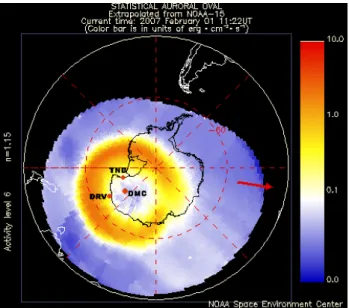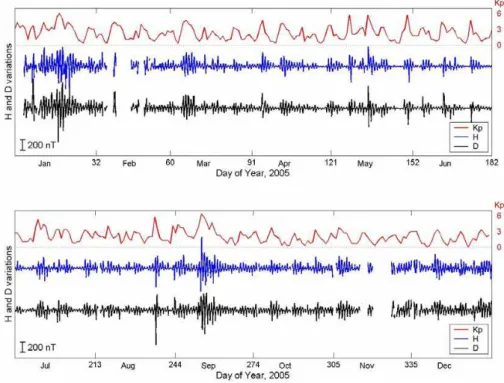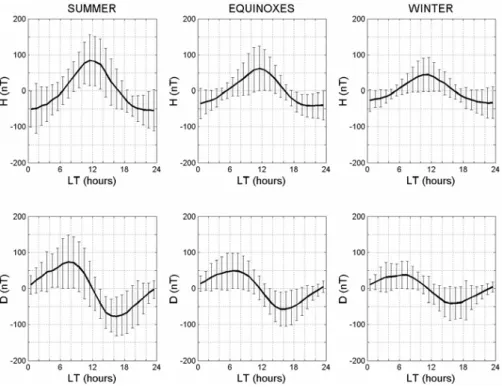HAL Id: hal-00330146
https://hal.archives-ouvertes.fr/hal-00330146
Submitted on 2 Oct 2007
HAL is a multi-disciplinary open access
archive for the deposit and dissemination of
sci-entific research documents, whether they are
pub-lished or not. The documents may come from
teaching and research institutions in France or
abroad, or from public or private research centers.
L’archive ouverte pluridisciplinaire HAL, est
destinée au dépôt et à la diffusion de documents
scientifiques de niveau recherche, publiés ou non,
émanant des établissements d’enseignement et de
recherche français ou étrangers, des laboratoires
publics ou privés.
Daily variation at Concordia station (Antarctica) and its
dependence on IMF conditions
L. Cafarella, D. Di Mauro, S. Lepidi, A. Meloni, M. Pietrolungo, L. Santarelli,
J. J. Schott
To cite this version:
L. Cafarella, D. Di Mauro, S. Lepidi, A. Meloni, M. Pietrolungo, et al.. Daily variation at
Con-cordia station (Antarctica) and its dependence on IMF conditions. Annales Geophysicae, European
Geosciences Union, 2007, 25 (9), pp.2045-2051. �hal-00330146�
www.ann-geophys.net/25/2045/2007/ © European Geosciences Union 2007
Annales
Geophysicae
Daily variation at Concordia station (Antarctica) and its dependence
on IMF conditions
L. Cafarella1, D. Di Mauro1, S. Lepidi1, A. Meloni1, M. Pietrolungo1, L. Santarelli1, and J. J. Schott2
1Istituto Nazionale di Geofisica e Vulcanologia, Roma, Italy
2Ecole et Observatoire des Science de la Terre, IPG, Strasbourg, France
Received: 11 April 2007 – Revised: 6 September 2007 – Accepted: 18 September 2007 – Published: 2 October 2007
Abstract. After some short test surveys, during the 2004–2005 summer expedition in Antarctica, a geomagnetic French-Italian observatory was installed on the plateau (ge-ographic coordinates: 75.1◦S, 123.4◦E; corrected geomag-netic coordinates: 88.9◦S, 54.3◦E; UT=LT−8) very close to the geomagnetic pole. In this paper we present some pecu-liarities of the daily variation as observed at this polar cap observatory during the years 2005 and 2006, taking into ac-count the different Loyd seasons and different interplanetary magnetic field conditions. Some interesting results emerge from the analysis, confirming the dependence of the daily variation (and of the associated polar current systems) on the IMF Bz and By components. In particular the
analy-sis showed that different Bzconditions correspond to
differ-ent contribution to daily variation of ionospheric and field aligned currents, while particular Byconditions lead to a time
shift of the diurnal variation, indicating an asymmetry with respect to the noon meridian.
Keywords. Geomagnetism and paleomagnetism (Time
vari-ations, diurnal to secular) – Magnetospheric physics (Polar cap phenomena; Solar wind-magnetosphere interactions)
1 Introduction
The ground measurements of magnetic field variations in the polar regions are an important tool for plasma processes anal-ysis (e.g. Lanzerotti et al., 1994; Villante et al., 1997; Yagova et al., 2002, 2004, and the references therein). In particular, the daily variation (24 h period and its harmonics) is gener-ated in the polar cap by two different current systems: Sq0 (the extrapolation of the mid latitude Sq system driven by
the ionospheric dynamo) and the polar cap system Sqp,
re-lated to field aligned currents flowing along the geomagnetic
Correspondence to: L. Cafarella
(cafarella@ingv.it)
field lines from the magnetosphere to the ionosphere. The Sqp
system is generated by external sources related to processes in the magnetosphere and its interaction with the Interplan-etary Magnetic Field (IMF) (e.g. Ractliffe, 1972; Kivelson and Russel, 1996; Brekke, 1997) and is believed to be the pri-mary source for the high latitude daily variations, especially during local winter when the polar cap ionospheric ioniza-tion due to solar radiaioniza-tion is strongly reduced (e.g. Akasofu et al., 1983; Brekke, 1997).
In 1994 France and Italy started a collaboration for opening the permanent scientific station Concordia on the high East Antarctic craton, at Dome C (geographic latitude 75◦06′S, longitude 123◦23′E, about 950 km away from the coast). Concordia is located 1200 km away from Mario Zucchelli Station (Italy), 560 km from Vostok (Russia) and 1100 km from Dumont D’Urville (France). As a result of this agreement the national Antarctic Programs (IPEV and PNRA respectively) started logistic, technical and scientific activi-ties that initiated with the realization of a summer camp. The permanent Base opened in February 2005, during 2004–2005 summer expedition.
After some preliminary tests, a geomagnetic observatory has been installed at Concordia station at the end of 2004. Variations in the Earth’s magnetic field are continuously monitored by a three-axis fluxgate magnetometer along three orthogonal vector components oriented with respect to the lo-cal magnetic meridian. The fundamental sampling rate is 1 s for the vectorial magnetometer and 5 s for the scalar mag-netometer with a data storing rate of 1 min. The total field intensity is measured by an Overhauser magnetometer. Ab-solute measurements are performed more or less regularly over most of the year. The Antarctic geomagnetic observa-tory at Concordia Station (DMC) is located near 89◦ geo-magnetic latitude, deep in the geogeo-magnetic polar cap. The location of the observatory, with a statistical pattern of auro-ral power flux based on data from the Total Energy Detector (TED) on board the NOAA-15 satellite (courtesy of the U.S.
2046 L. Cafarella et al.: Daily variation at Concordia station and its dependence on IMF conditions
Fig. 1. Current extent and position of the auroral oval in the
Southern Hemisphere, extrapolated from measurements taken dur-ing a recent polar pass of the NOAA POES satellite (from http: //www.sec.noaa.gov). The position of DMC, TNB and DRV obser-vatories is also reported.
Department of Commerce, NOAA, Space Environment Cen-tre) over Antarctica, are shown in Fig. 1. In the same figure also the position of the Italian and French coastal geomag-netic observatories (indicated as TNB and DRV respectively) are reported.
In a previous paper (Santarelli et al., 2007), we analyzed the daily variation as observed at the geomagnetic obser-vatory TNB (corrected geomagnetic latitude 80.0◦S); the analysis, based on fourteen years of data, has shown a pro-nounced seasonal effect on the amplitude of the diurnal varia-tion, but not on its pattern. A preliminary analysis of the daily variation at DMC, based on a short data set (less than one month) recorded during the 1999–2000 summer campaign was also undertaken; we found that the 24-h variation is well evident on both horizontal elements, with a pronounced am-plitude day-to-day variability, related to the global magneto-spheric activity level (Lepidi et al., 2003).
In this paper we further investigate the daily variation char-acteristics as recorded at DMC, i.e. deep in the polar cap. The availability of a longer data set, recorded during the whole 2005 and 2006, allowed to focus our attention on the daily variation seasonal dependence and on the influence of IMF.
In the study of magnetospheric phenomena, especially at high latitude, magnetic local time (MLT) is an important pa-rameter. However, MLT becomes meaningless approaching the geomagnetic pole, where it can not be defined. For this reason, in the following analysis we use the geographic local time (LT) as ordering parameter.
2 Experimental observations
The daily variation analysis is performed using hourly aver-age values of the variations of the geomagnetic field horizon-tal elements H and D. The tohorizon-tal number of used hourly data is about 16 000. The hourly values during the 2005 year, to-gether with the daily averages of the Kpindex, are shown in
Fig. 2 as an example. The presence of a quite regular 24-h variation, whose amplitude strongly varies from day to day, being closely related to Kp, is clearly evident. During winter,
when magnetic activity is lower than summer, the daily vari-ation almost vanishes (see for example the days with Kp=0+
at the end of May and of June); conversely, during summer the daily variation is always present, although with a smaller amplitude, even when Kp=0 (at the beginning and the end
of December). In order to better investigate this feature, we computed individual power spectra for consecutive 72-h in-tervals with a step size of 24-h and obtained, for the whole two-year analyzed period, 557 spectra. These spectra, as ex-pected, show a persistent peak in correspondence of 24-h. As shown in Fig. 3, the logarithmic total horizontal power (H power + D power) of the 24-h peak is well related with the 3-day averages of the Kpindex and the correlation coefficient
is slightly higher during winter (similar results are obtained considering the two components separately). Moreover, the slope of the best linear fit considerably increases from sum-mer to winter: in this sense, the plots clearly show that the 24-h power level for the highest Kp values (around 4 and
more) is comparable in the different seasons, while for very low Kp (<1) during winter it is of an order of magnitude
lower with respect to summer. Our findings shown in Figs. 2 and 3 on the relation between the diurnal variation ampli-tude and Kp and its seasonal dependence can be attributed
to the strong reduction of Sqp in the whole year during very
quiet magnetospheric conditions and, only in winter, to the absence of the polar extension of the Sq0, whose amplitude is not related to Kp.
In Fig. 4 we show the daily distribution of the average hourly values of the H and D elements and their standard deviation; the average value of the whole data time series has been subtracted to the data. The analysis has been per-formed separately for three seasons selected according to the Lloyd criteria (Lloyd, 1861): summer (November, Decem-ber, January and February), left panels; equinoxes (March, April, September and October), center panels; winter (May, June, July and August), right panels. The plots were obtained by laying one day data on top of another; in this way a sin-gle point represents the variation at a fixed LT hour averaged over the whole season; each of these points has been obtained averaging about 200 data.
From Fig. 4 is clear that, independently on the season, the H variation is symmetric around local noon with a maximum between 11:00 and 12:00 LT, while the D variation is anti-symmetric, with a maximum in the local morning and a min-imum in the local afternoon (around 07:00 LT and 16:00 LT,
Fig. 2. Hourly values of the variations of the H and D components during 2005, with the daily averages of the Kpindex.
Fig. 3. The total (H+D) 24-h power versus the Kpindex. The equation of the best linear fit and the value of the correlation coefficient are
indicated.
respectively). The pattern of the diurnal variation does not show a seasonal dependence. Conversely, the amplitude of the variation depends on season, being larger during local summer (around 140 nT for both components) and smaller during winter (around 80 nT). Also the amplitude of the er-ror bars is larger during local summer, indicating a larger day-to-day variability.
In order to investigate solar wind-magnetosphere interac-tion processes, we used IMF data from ACE spacecraft, in particular the IMF hourly key-parameters from CDAWEB, considering a time delay of 1 h from spacecraft position (at about 235 REin the Earth-Sun direction) to Earth.
We computed the daily variation pattern for the three seasons separately for positive and negative values of the
IMF Bz axial dipole parallel component that correspond
to reduced and expanded polar cap conditions, respectively (Iijima, 2000). The results are shown in Fig. 5, in which each point has been obtained averaging about 100 data. It is evi-dent that the amplitude of the variation is definitively larger for Bz<0, than for Bz>0; also standard deviation takes on
larger values in the condition of Bz<0. It can also be seen
that the amplitude reduction from summer to winter is larger for Bz>0 (being about a factor 2.5 for both components) than
for Bz<0 (about a factor 1.6). This feature can be interpreted
taking into account that for southward IMF conditions the daily variation is mainly due to field aligned currents, which show a moderate reduction in winter; conversely, for north-ward IMF conditions also the contribution of ionospheric
2048 L. Cafarella et al.: Daily variation at Concordia station and its dependence on IMF conditions
Fig. 4. Daily distribution of the average hourly values and their standard deviation for the H and D components, considering separately the
three Lloyd seasons.
currents, which strongly depend on photo-ionization from the Sun (Friis-Christensen and Wilhjelm, 1975), is impor-tant. From Fig. 5 it can also be noted that for Bz<0 there is
also a slight temporal shift of the diurnal variation to earlier hours from summer to winter.
In Fig. 6 we show the diurnal variation for Bz>0 and
|By|>Bz (where Byis the east-west IMF component),
sep-arately for positive and negative By (corresponding
respec-tively to By>Bz and By<–Bz, respectively); each point has
been obtained averaging about 100–150 data. It is interest-ing to point out that for negative Bythe pattern of the diurnal
variation is shifted earlier of about 3 h with respect to positive By. For example, the H component maximum is at 09:00–
10:00 LT for By<0 and at 12:00–13:00 LT for By>0, and
the D component maximum is at 05:00 LT and 09:00 LT, re-spectively. It is also evident that for both elements the ampli-tude and standard deviation of the diurnal variation is larger, almost by a factor two, for negative By.
This result confirms that the polar cap electric current sys-tem Spq (generated by external sources related to processes in
the magnetosphere and its interaction with IMF) deeply de-pends on By. In order to better investigate this phenomenon,
we analyzed also the seasonal dependence of the daily vari-ation for positive Bzand negative Byconditions (Fig. 7). In
this case the curves are not very regular, due to the poorer statistics (each point has been obtained averaging about 30– 40 data); however the results indicate that the shift toward earlier hours of the diurnal variation for By<0 is more
pro-nounced during winter, when the solar irradiation is com-pletely absent and the electric current polar system is poorly influenced by the ionospheric Sqelectric current system.
3 Summary
The diurnal variation of geomagnetic field elements is a well known phenomenon that has been extensively studied espe-cially at mid latitudes, where Sq electric current system is
driven by the ionospheric dynamo and consists of two current vortices, centered at about 40◦latitude N and S, respectively. An equivalent electric current system is used in polar region to represent the source of the observed field. This current system is called Sqp(Solar quiet polar) and is related to
mag-netospheric convection generating a quasi permanent current system steadily oriented respect to the Sun-Earth line. In this paper data from Dome C, a polar cap observatory, were analysed for the years 2005 and 2006 in order to investigate daily variation dependence on magnetospheric and IMF con-ditions.
The first result found is the evidence of a strong relation between the daily variation amplitude and the Kpindex
dur-ing the whole year. This result confirms our previous find-ings obtained from a short data set during summer (Lepidi et al., 2003). Moreover, we found that the relation between the diurnal variation amplitude and Kpshows a seasonal
depen-dence, in that the correlation coefficient is higher during win-ter and the slope of the best linear fit considerably increases
Fig. 5. Daily distribution of the average hourly values and their
stan-dard deviation for the H and D components, separately for the three Lloyd seasons, for northward (left panels) and southward (right pan-els) IMF conditions.
from summer to winter: indeed, for high Kp conditions, the
amplitude of the daily variation is comparable in the different seasons; conversely when the Kpindex attains minimum
val-ues, the daily variation is much more reduced during winter, being of an order of magnitude smaller than during summer. These findings indicate that in the polar region the amplitude of the daily variation is strongly dependent on high latitude electric current system, while the contribution of the polar extension of Sq, whose amplitude is not related to Kp, is
negligible, especially during winter.
It was also found that the amplitude of the daily variation, which decreases from summer to winter, strongly depends on IMF conditions, being larger when Bz<0 (expanded polar
cap region; Iijima, 2000). Moreover the amplitude reduction from summer to winter is larger for Bz>0, indicating that
in this case the contribution of ionospheric currents (strongly dependent on photo-ionization from the Sun) could be impor-tant, while for Bz<0 the key role is played by field aligned
currents, with a moderate seasonal variation.
At high latitude also the east-west IMF component, By,
plays a main role in determining geomagnetic variations. In-deed, for Bz<0, the By component creates an asymmetry
about the noon-midnight meridian in the evolution of newly opened field lines (Svalgaard-Mansurov effect; see for ex-ample Zhou et al., 2000; Stubbs et al., 2001). Moreover,
Fig. 6. Daily distribution of the average hourly values and their
standard deviation for the H and D components, for Bz>0 and
|By|>Bz, separately for positive and negative By.
more recently many authors have shown the importance of By also for positive Bz conditions: in this case, the
exis-tence and the geometry of the polar cap, as well as the lo-cal current geometry, is deeply connected to the value of the By component (Vennstrom et al., 2002, 2005; Park et al.,
2006). Indeed, the introduction of an eastward IMF com-ponent, during northward IMF conditions, gradually opens the magnetosphere poleward of the cusp (as originally sug-gested by Burch, 1973), changing the pattern of the iono-spheric currents that will be located asymmetrically respect to the noon-midnight meridian; in particular, in the South-ern Hemisphere, dusk (dawn) side currents are enhanced for positive (negative) By and this asymmetry increases when
Byincreases with respect to Bz(Vennstrom et al., 2005). In
this sense our results have shown that, for positive Bz, when
2050 L. Cafarella et al.: Daily variation at Concordia station and its dependence on IMF conditions
Fig. 7. Daily distribution of the average hourly values and their
stan-dard deviation for the H and D components, for Bz>0 and By<–Bz,
separately for summer and winter seasons.
respect to By>0 and this time shift is even more evident
dur-ing winter. Moreover the amplitude of the diurnal variation is larger, almost by a factor two, for By<0 when in general the
magnetic activity in the high latitude Southern Hemisphere tends to be higher (Nishida, 1978).
Acknowledgements. The research activity at DMC is supported by
Italian PNRA and French IPEV. The work of M. Pietrolungo and L. Santarelli was supported by a PNRA fellowship.
The authors would like to thank the two referees for their helpful comments and suggestions on the manuscript.
Topical Editor I. A. Daglis thanks K. Yumoto and another anonymous referee for their help in evaluating this paper.
References
Akasofu, S. I., Ahn, B. H., and Romick, G. J.: A study of the polar current system using the IMS meridian chains of magnetometers, Space Sci. Rev., 36, 337–413, 1983.
Brekke, A.: Physics of the upper polar atmosphere, John Wiley & Sons Ltd in association with Praxis Publishing Ltd, p. 491, 1997. Burch, J. L.: Rate of erosion of dayside magnetic flux based on a quantitative study of polar cusp latitude on the interplanetary magnetic field, Eos T. Am. Geophys. Un., 54, 1286–1286, 1973. Friis-Christensen, E. and Wilhjelm, J.: Polar cap currents for dif-ferent directions of the interplanetary magnetic field in the Y-Z plane, J. Geophys. Res., 80, 1248–1260, 1975.
Kivelson, M. G. and Russell, C. T.: Introduction to Space Physics, Cambridge University Press, p. 568, 1996.
Iijima, T.: Field-aligned currents in geospace: substance and sig-nificance, Magnetospheric Current Systems, edited by: Ohtani, S.-I., Fujii, R., Hesse, M., Lysak, R. L., Gephysical Monograph, 118, 107–129, 2000.
Lanzerotti, L. J., Meclennan, L. V., and Medford, L. V.: Inferred quasi-steady ionospheric neutral winds and electrical currents at 79◦ south latitude in austral summer condition, Geophys. Res. Lett., 21, 217–220, 1994.
Lepidi, S., Cafarella, L., Francia, P., Meloni, A., Palangio, P., and Schott, J. J.: Low frequency geomagnetic field variations at Dome C (Antartica), Ann. Geophys., 21, 923–932, 2003, http://www.ann-geophys.net/21/923/2003/.
Lloyd, H.: On earth-currents, and their connexion with the diur-nal changes of the horizontal magnetic needle, Trans. Roy. Irish Acad., 24, 115–141, 1861.
Nishida, A.: Geomagnetic diagnosis of the magnetosphere, Springer-Verlag, 1978.
Park, K. S., Ogino, T., and Walker, R. J.: On the im-portance of antiparallel reconnection when the dipole tilt and IMF By are nonzero, J. Geophys. Res., 111, A05202,
doi:10.1029/2004JA010972, 2006.
Ratcliffe, J. A.: An introduction to the ionosphere and magneto-sphere, Com. Uni Press, Cambridge, p. 256, 1972.
Santarelli, L., Cafarella, L., Lepidi, S., Di Mauro, D., Meloni, A., and Palangio, P.: Fourteen years of geomagnetic daily variation at Mario Zucchelli Station (Antarctica), Ann. Geophys.-Italy, 50, 227–234, 2007.
Stubbs, T. J., Lockwood, M., Cargill, P., Fennell, J., Grande, M., Kellett, B., Perry, C., and Rees, A.: Dawn-dusk asymmetry in particles of solar wind origin within the magnetosphere, Ann. Geophys., 19, 1–9, 2001,
http://www.ann-geophys.net/19/1/2001/.
Vennerstrom, S., Moretto, T., Olsen, N., Friis-Christensen, E., and Stampe, A. M.: Field aligned currents in the dayside cusp and polar cap region during northward IMF, J. Geophys. Res., 107, A009162, doi:10.1029/2001JA009162, 2002.
Vennerstrom, S., Moretto, T., Rastatter, L., and Raeder, J.: Field-aligned currents during northward interplanetary magnetic field: Morphology and causes, J. Geophys. Res., 110, A06205, doi:10.1029/2004JA010802, 2005.
Villante, U., Lepidi, S., Francia, P., Meloni A., and Palangio, P.: Long period geomagnetic field fluctuations at Terra Nova Bay (Antarctica), Geophys. Res. Lett., 24, 1443–1446, 1997. Yagova, N. V., Lanzerotti, L. J., Villante, U., Pilipenko, V. A.,
Le-pidi, S., Francia, P., Papitashvili, V. O., and Rodger, A. S.: ULF
Pc5-6 magnetic activity in the polar cap as observed along a geo-magnetic meridian in Antarctica, J. Geophys. Res., 107, SMP22, doi:10.1029/2001JA900143, 2002.
Yagova, N. V., Pilipenko, V. A., Lanzerotti, L. J., Engebret-son, M. J., Rodger, A. S., Lepidi S., and Papitashvili, V. O.: Two-dimensional structure of long-period pulsations at po-lar latitudes in Antarctica, J. Geophys. Res., 109, A03222, doi:10.1029/2003JA010166, 2004.
Zhou, X. W., Russell, C. T., Le Fuselier, S. A., and Scudder, J. D.: Solar wind control of the polar cusp at high altitude, J. Geophys. Res., 105, 245–251, doi:10.1029/1999JA900412, 2000.




